The Ventricular Vein: Anatomy and Clinical Insights
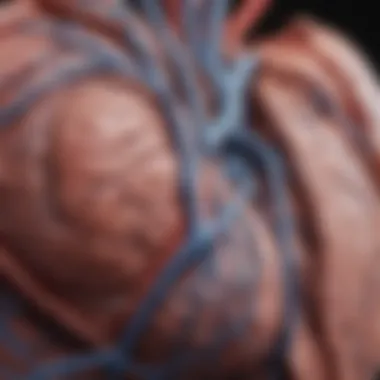
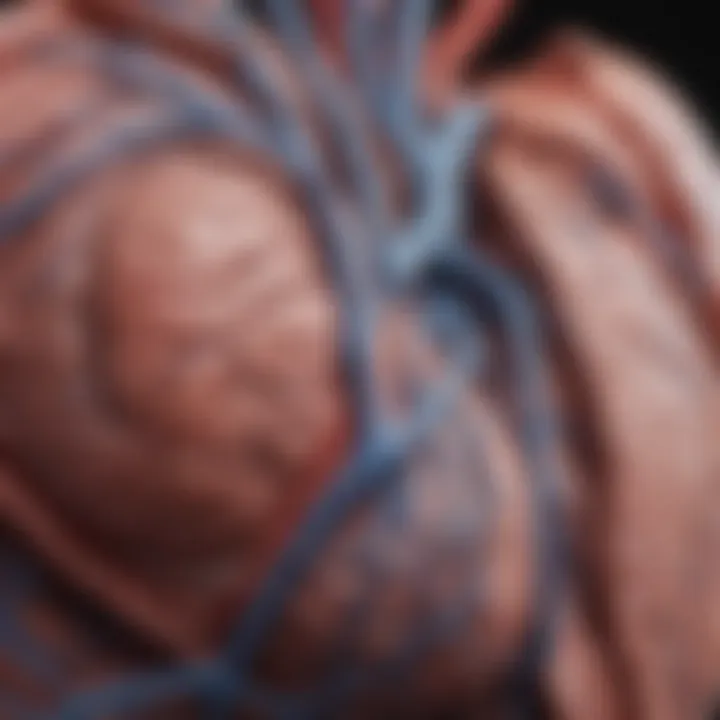
Overview of Research Topic
Brief Background and Context
The ventricular vein, a critical component of the cardiovascular system, plays an essential role in the venous drainage of blood from the heart. Its anatomical and physiological nuances serve fundamental functions in maintaining hemodynamics and facilitating efficient circulation. Understanding this structure enhances the comprehension of cardiac pathology and the complexities involved in surgical interventions and clinical practices.
Importance in Current Scientific Landscape
In recent years, there has been an intensified focus on the ventricular vein within the medical community. Its relevance extends not only to cardiovascular health but also to its implications in congenital heart defects, arrhythmias, and other cardiac conditions. Improved insights into its anatomy and variations can significantly impact clinical outcomes and techniques employed in interventions.
Methodology
Research Design and Approach
The exploratory nature of this research encompasses a systematic review of existing literature, anatomical studies, and clinical case evaluations. The aim is to synthesize current findings with respect to anatomical variations, embryonic development, and associated pathologies. This multi-faceted approach provides a comprehensive overview of the ventricular vein's role in both health and disease.
Data Collection Techniques
Data collection primarily involves utilizing peer-reviewed journals, anatomical databases, and clinical case studies. By collating information from these diverse sources, a well-rounded understanding of the ventricular vein is developed. This evidence-based methodology ensures that the findings are both relevant and applicable to contemporary medical practice.
Intro to the Ventricular Vein
The ventricular vein is crucial in the study of cardiovascular health. Understanding its anatomy and function can lead to better insights into various clinical practices. This introduction serves not only to familiarize the reader with the ventricular vein but also to emphasize its importance in both anatomical and clinical contexts.
It is vital to appreciate how this vascular structure interacts with other components of the circulatory system. A clear comprehension of this can shine a light on significant physiological processes and potential clinical implications. Notably, the ventricular vein plays a pivotal role in venous return, directly affecting heart function and overall cardiovascular efficiency.
Moreover, the complexities involved in its anatomy offer a backdrop to various pathologies that may arise, emphasizing the need for accurate diagnosis and intervention.
Investing time to understand the ventricular vein is not just academic; it holds immense clinical relevance that can influence patient outcomes significantly.
Definition and Significance
The ventricular vein is a major venous structure associated with the heart's ventricles. It primarily serves to collect deoxygenated blood and transport it back towards the heart for reoxygenation. This function is fundamental for maintaining the efficiency of the cardiac cycle and supporting the body's overall homeostasis.
The significance of this structure goes beyond its anatomical definition. In clinical scenarios, disorders involving the ventricular vein can lead to substantial physiological implications, such as impaired circulation and reduced cardiac output, which can jeopardize patient health.
Understanding the definition of the ventricular vein allows healthcare professionals to better appreciate its role in cardiovascular physiology and the potential challenges that may arise in various medical conditions.
Historical Context
The study of the ventricular vein has evolved significantly over centuries. Early anatomical explorations did not fully capture its complexity, leading to misconceptions that overshadowed its functional importance. As scientific methods progressed, more detailed mapping of the cardiovascular system unfolded.
In the 19th century, the development of more advanced imaging techniques and cadaver studies began to shed light on the precise anatomical locations and connections of the ventricular vein. This knowledge significantly impacted surgical approaches and treatment strategies related to cardiovascular health.
Understanding its history helps contextualize current practices in medicine. Researchers and clinicians now possess a clearer understanding of the ventricular vein's role, reinforcing its importance in health and disease management. The historical perspective adds depth to the contemporary discourse surrounding this crucial vascular structure.
Anatomy of the Ventricular Vein
The anatomy of the ventricular vein is pivotal to understanding both normal physiological conditions and various cardiovascular pathologies. This section will delve into the specifics of the ventricular vein’s location, structural characteristics, and its interplay with other vascular entities. Comprehension of this anatomy provides essential insights, especially in clinical practice where any alterations may have significant implications for cardiac health.
Location and Structure
The ventricular vein primarily refers to the cardiac veins associated with the ventricles of the heart. These veins are crucial for the effective draining of deoxygenated blood from the myocardium back to the right atrium through the coronary sinus. The anatomical layout consists of multiple veins including the great cardiac vein, middle cardiac vein, and small cardiac vein, which collectively ensure proper venous return.
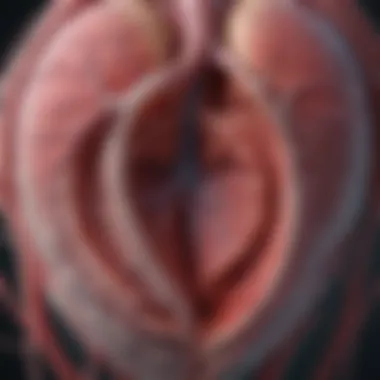
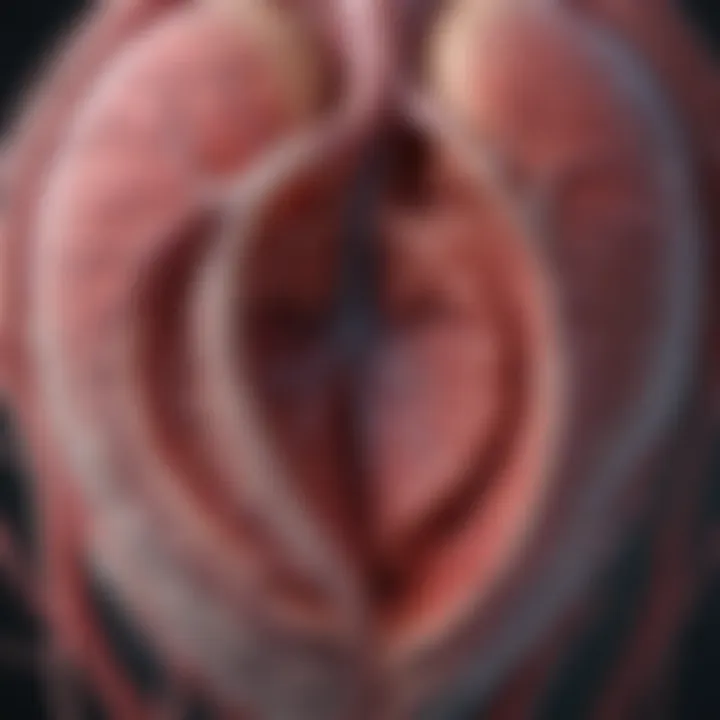
The great cardiac vein runs alongside the anterior interventricular artery, tracing a course from the apex of the heart towards the left atrium. Meanwhile, the middle cardiac vein corresponds to the posterior interventricular artery, and the small cardiac vein is located near the right atrium. Understanding these locations aids in pinpointing areas susceptible to venous blockages or thrombosis, which can lead to severe complications.
Connections with Other Vascular Structures
The ventricular vein does not function in isolation. It is intricately connected to numerous vascular structures. Its primary connection is with the coronary sinus, a large vein that collects blood from the heart muscle and directs it into the right atrium. Various smaller cardiac veins drain distinct regions of the myocardium and converge into the coronary sinus.
The interactions between these vascular structures facilitate the venous return process, which is crucial for maintaining optimal cardiac output. Any disruption in these connections can result in significant cardiovascular issues, highlighting why anatomical knowledge is paramount for healthcare professionals targeting cardiac diagnoses and therapies.
Variations in Anatomy
Anatomical variations of the ventricular vein can occur due to development, individual differences, or pathological conditions. Notably, the coronary sinus can exhibit various shapes and sizes among individuals, affecting how blood is drained from the veins of the myocardium.
In some individuals, additional veins may also be present, such as an accessory cardiac vein, which could drain blood from specific areas directly into the right atrium. Recognizing these variations is necessary for surgical interventions and for interpreting imaging results correctly, as anatomical anomalies can have significant implications for treatment options, especially in procedures like cardiac catheterization.
The understanding of anatomical variations is not just of academic interest; it plays a critical role in effective patient care and surgical planning.
In summary, the anatomy of the ventricular vein provides foundational knowledge essential for understanding broader cardiovascular health. Its location, structural nuances, and connections inform clinical practice, especially concerning patient assessments and interventions.
Physiological Functions
Understanding the physiological functions of the ventricular vein is crucial for grasping its significance in the cardiovascular system. This section elucidates how the ventricular vein contributes to venous return and its consequent impact on cardiac function, shedding light on its role in maintaining circulatory efficiency and overall heart health.
Role in Venous Return
The ventricular vein plays a vital role in the venous return system. Venous return refers to the flow of deoxygenated blood back to the heart, specifically to the right atrium. The efficiency of this process is essential for maintaining optimal cardiac output. The ventricular vein facilitates the proper drainage of blood from the heart muscle.
Several key aspects highlight its importance:
- Gravity-Aided Return: The anatomical position of the ventricular vein allows blood to descend into it under the influence of gravity, thus promoting efficient flow.
- Pressure Difference: As the heart pumps blood, changes in pressure within the thoracic cavity assist in drawing blood back through the ventricular vein, enhancing the return flow during diastole.
- Valve Functionality: Valves present in the ventricular veins help prevent backflow, ensuring unidirectional flow and maintaining a consistent return rate to the heart.
These factors together enhance the overall effectiveness of venous return, positively impacting the efficiency of the entire cardiovascular system.
Impact on Cardiac Function
The ventricular vein significantly influences cardiac function through its role in maintaining hemodynamic stability. Adequate venous return is paramount for ensuring the heart receives sufficient blood volume, which directly affects cardiac workload and output.
- Stroke Volume Regulation: Increased blood return leads to increased preload, which enhances stroke volume through the Frank-Starling mechanism; this is a physiological principle that states that the heart will pump more forcefully when filled with greater volumes of blood.
- Oxygen Delivery: The efficiency of blood return directly correlates with the oxygen supply to the myocardium, impacting overall cardiac performance and stamina during physical exertion.
- Adaptation to Demands: The ventricular vein adapts to varying physiological demands, such as exercise or rest. When the body requires more oxygen, the heightened venous return fosters a corresponding increase in heart rate and output.
"The health of the heart is not solely determined by its pumping ability but by the entire system of blood returning to it."
Such insights into the physiology of the ventricular vein can be pivotal in both clinical and educational settings, guiding further research and informed medical decisions.
Embryonic Development
Embryonic development is a crucial aspect when discussing the ventricular vein. Understanding how this vascular structure forms can provide insight into its functionality and the potential for related cardiac anomalies. During early stages of embryonic growth, various vessels establish connections, which are vital for ensuring adequate blood flow. Proper development of the ventricular vein directly influences the overall formation of the cardiovascular system. Therefore, studying its embryogenesis is essential not just for anatomical knowledge, but also for comprehending potential clinical implications later in life.
Developmental Stages
The development of the ventricular vein occurs over several stages within the embryonic period. Initially, during the gastrulation phase, the foundation for the cardiovascular system begins to take shape. This phase involves the migration of mesodermal cells, which eventually give rise to the heart and its associated structures.
As development progresses to the cardiogenic phase, blood vessels begin forming from aggregates of mesodermal cells. The early endothelial lining arises, leading to the creation of primitive veins. This primitive venous system gradually transforms into more defined structures, including the ventricular vein.
By the time the embryo reaches the fetal stage of development, the ventricular vein's architecture becomes more complex. At this point, it establishes vital connections with other vascular paths, allowing for effective venous return from the heart. This detailed evolution is significant, as disruptions during these stages can lead to various congenital heart defects.
Influences on Cardiac Anatomy
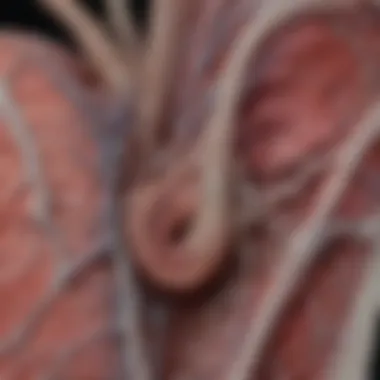
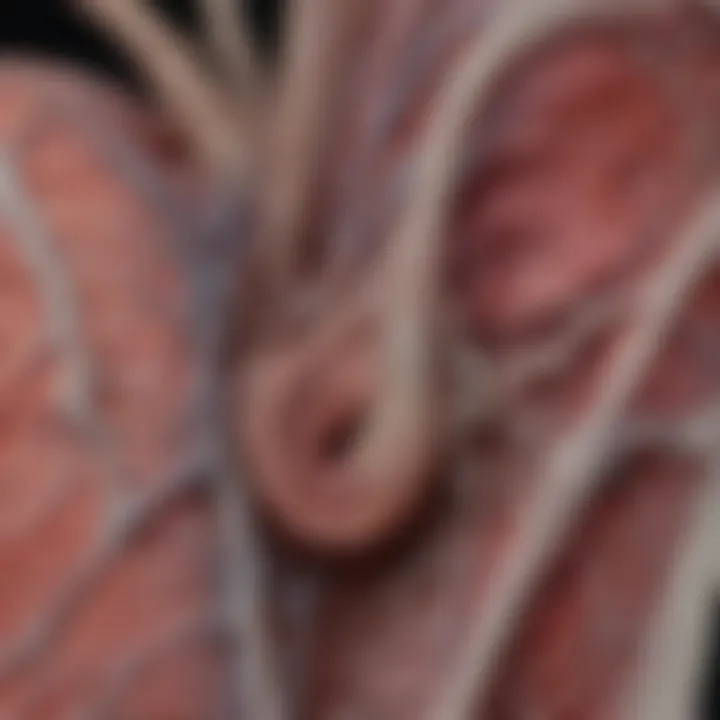
The formation of the ventricular vein does not occur in isolation; it affects and is affected by the overall anatomy of the heart and cardiovascular system. As the ventricular vein develops, it undergoes changes that dictate how the heart will function postnatally. Its position and connectivity with other major vessels can influence the hemodynamics within the heart.
Additionally, alterations in the embryonic development of the ventricular vein may lead to anatomical variations that could result in pathological conditions later in life. For example, studies show that abnormalities during the transition from the primitive vein to a fully formed ventricular vein may predispose individuals to venous thrombosis or other vascular complications.
In summary, embryonic development plays a significant role in the anatomy and functionality of the ventricular vein. The stages of its growth set a foundation that can affect cardiovascular health throughout life, making this topic of substantial importance for both clinical practice and research.
Pathologies Associated with the Ventricular Vein
The ventricular vein plays a significant role in the cardiovascular system. Understanding the pathologies associated with it is crucial for diagnosing and managing cardiovascular diseases. Pathologies like venous thrombosis, myocardial infarction, and congenital anomalies can severely impact heart function and overall health. In this section, we will explore these conditions in detail, discussing their mechanisms, implications, and treatment options.
Venous Thrombosis
Venous thrombosis refers to the formation of a blood clot within the venous system, particularly in the ventricular vein. This condition interrupts normal blood flow and can lead to serious complications such as pulmonary embolism. It is essential to identify risk factors, such as prolonged immobility, obesity, and genetic predisposition, to mitigate the occurrence of venous thrombosis.
The clinical manifestations can vary from minimal symptoms to severe pain and swelling in the affected area. Diagnostic imaging techniques, including ultrasound, are vital in confirming the presence of a thrombus. Treatment typically involves anticoagulant therapy to prevent further clot formation. In some cases, surgical intervention may be necessary to remove the clot.
Infarction and Ischemia
Infarction occurs when there is a complete obstruction of blood flow in the ventricular vein, leading to tissue death due to lack of oxygen. Ischemia, on the other hand, is characterized by reduced blood flow, which does not completely obstruct the vessel but can still cause significant damage over time. Both conditions could arise from a variety of factors, including arterial blockage, severe hypotension, or cardiomyopathy.
Symptoms of infarction typically include chest pain, shortness of breath, and feeling faint. Timely intervention is crucial. Treatment strategies may involve reperfusion therapies, such as thrombolysis or percutaneous coronary intervention, aimed at restoring blood flow and minimizing heart damage. Understanding the relationship between these conditions and the ventricular vein is vital for effective clinical management.
Congenital Anomalies
Congenital anomalies of the ventricular vein can impact its structure and function from birth. These malformations might lead to various complications, including obstructive venous disorders or aberrant connections with other vascular structures. Examples of congenital anomalies include agenesis of the ventricular vein and abnormalities in its formation or structure.
Detection of these anomalies is often made through imaging studies or during surgical procedures. Management may include monitoring the patient for any associated symptoms or conditions. In cases where the anomalies lead to significant issues, surgical intervention may be required to correct the anatomical defects.
Diagnostic Imaging Techniques
Diagnostic imaging plays a critical role in the assessment and understanding of the ventricular vein. By utilizing various imaging modalities, clinicians can visualize the structure, assess function, and detect abnormalities within this important vascular component. The ability to accurately diagnose conditions related to the ventricular vein assists in formulating appropriate treatment plans and can greatly enhance patient outcomes. This section will explore the significance of ultrasound imaging and MRI and CT imaging, which are the key techniques used in practice.
Ultrasound Imaging
Ultrasound imaging is a non-invasive method that employs high-frequency sound waves to create real-time images of the body’s internal structures. It is widely recognized for its utility in examining vascular systems, including the ventricular vein. Key advantages of ultrasound include:
- Real-time Visualization: Helps in observing blood flow and identifying thrombus formation in the vein.
- Accessibility and Cost-effectiveness: Ultrasound machines are generally easier to access and less expensive compared to other imaging techniques.
- Lack of Ionizing Radiation: This makes ultrasound a safer choice for certain populations, especially pregnant women.
However, there are limitations. The effectiveness of ultrasound can be influenced by patient factors such as obesity or excessive bowel gas, which can obscure images. Furthermore, the operator's skill level is crucial for obtaining high-quality results.
MRI and CT Imaging
Magnetic Resonance Imaging (MRI) and Computed Tomography (CT) have become indispensable tools in the modern assessment of the ventricular vein. Each modality offers distinct advantages.
- MRI: It provides excellent soft-tissue contrast and enables detailed visualization of vascular anatomy and pathology. MRI is particularly useful for evaluating venous thrombosis and complex vascular anomalies associated with the ventricular vein. Key points include:
- CT Scan: CT imaging is preferred for its speed and is particularly effective in assessing acute conditions, such as embolisms. It can provide a comprehensive view of the vascular system and detect complications such as infarction or ischemia. Important considerations for CT include:
- No Ionizing Radiation: Unlike CT, MRI does not use ionizing radiation, making it suitable for repeated studies.
- Contrast Agents: Gadolinium-based contrast agents may be used to enhance visualization, especially in identifying occlusions or congenital anomalies.
- High Spatial Resolution: CT offers detailed cross-sectional images, which aids in diagnosing issues within the ventricular vein.
- Rapid Acquisition: This makes it ideal in emergency situations where swift decisions are necessary.
Both MRI and CT imaging possess limitations, including accessibility and higher costs. Additionally, patients may experience contraindications related to contrast agents in MRI scanning. Utilizing a combination of these imaging techniques provides a more complete picture, assisting physicians in making informed clinical decisions.
"The integration of advanced imaging techniques in the assessment of the ventricular vein has revolutionized not only diagnosis but also the management of various cardiovascular conditions."
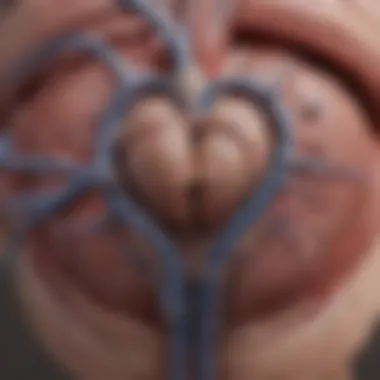
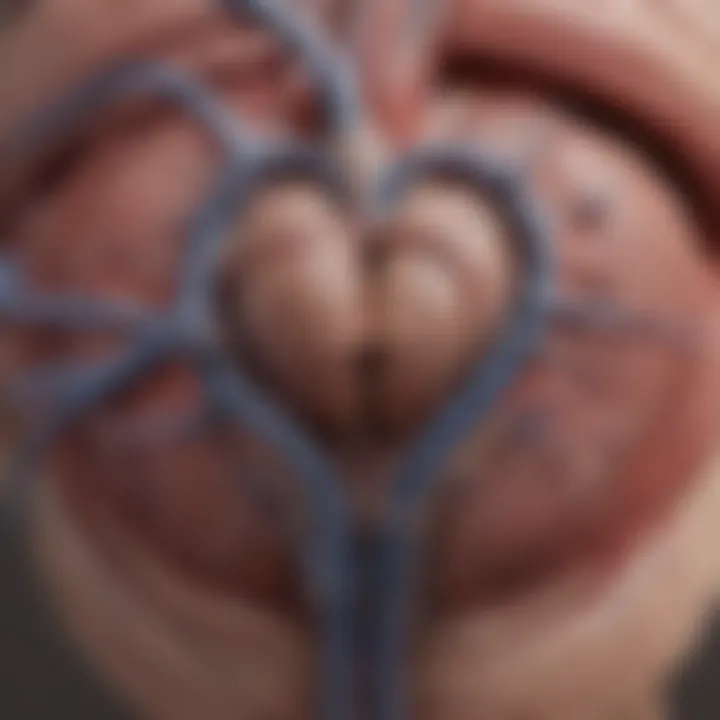
Surgical Interventions
The role of surgical interventions concerning the ventricular vein is critical, reflecting the complex interplay between anatomy and clinical practice. Understanding when surgery may be necessary and the specific techniques employed can significantly enhance patient outcomes. Surgical approaches not only address existing pathologies but also offer preventative strategies that are essential for managing cardiovascular health effectively.
Indications for Surgery
Surgery may be indicated in several scenarios related to the ventricular vein. Here are some primary considerations:
- Venous Thrombosis: The formation of a clot within the ventricular vein can lead to severe complications. If anticoagulant therapy is ineffective, surgery may be necessary to remove the thrombus.
- Congenital Anomalies: Certain congenital conditions may require surgical correction to ensure proper venous return and overall circulatory health. For instance, patients born with abnormal connections may face surgical interventions.
- Ischemic Events: In cases where ischemia is traced back to dysfunctional venous drainage, surgical options can restore normal blood flow and prevent myocardial infarction.
- Recurrent Infections: Some patients develop persistent issues with infection in vascular territories. When conservative management fails, surgical intervention may be warranted to remove infected tissue.
Each indication demands careful evaluation, as the decision to operate involves weighing risks against the potential benefits to the patient.
Surgical Techniques
Various surgical techniques exist that can address ventricular vein issues, each uniquely tailored to specific conditions.
- Thrombectomy: This technique involves the surgical removal of thrombus from the vein. It can restore normal blood flow and reduce the risk of further complications. Thrombectomy is often done using minimally invasive methods, which can result in shorter recovery times.
- Vein Repair: In cases where the structure of the vein is compromised, surgical techniques such as suturing or patching may be employed. This helps to maintain the integrity of the venous return system and ensure proper blood circulation.
- Revascularization Procedures: These involve creating new pathways for blood flow, especially in cases of severe ischemia. Techniques like bypass surgery or angioplasty may be used depending on the individual’s condition.
- Congenital Correction: For congenital anomalies, specific surgical techniques are utilized to correct the anatomical defects. These operations require a high degree of precision and often involve specialized pediatric cardiac surgeons.
Recent Research and Advances
The exploration of recent research surrounding the ventricular vein has become increasingly significant within the field of cardiovascular studies. Understanding current advancements provides key insights into the anatomical and physiological aspects of this structure, illuminating its role in various clinical contexts. Such research endeavors contribute to better diagnostic and surgical strategies, ultimately improving patient outcomes. Here, we discuss the latest trends in research focused on the ventricular vein and the future directions these studies might take.
Current Trends in Research
Recent studies have highlighted several trends that enhance our understanding of the ventricular vein. Notable advancements include:
- Imaging Techniques: The evolution of non-invasive imaging methods has allowed for more detailed study of the ventricular vein. Techniques like advanced MRI and high-resolution ultrasound have provided clearer visualizations, which assist in understanding its structure and function in health and disease.
- Pathophysiology: Researchers are delving into the molecular and cellular mechanisms that underlie pathologies involving the ventricular vein. By examining the genetic markers and inflammatory processes linked to venous thrombosis and congenital anomalies, there is a growing body of evidence that ties specific conditions to the function of this vein.
- Clinical Applications: New research often directly translates to clinical settings, influencing surgical protocols and intervention strategies. For instance, understanding how the ventricular vein behaves under various pathological conditions aids in refining approaches to cardiac surgery.
"Advancements in imaging and pathophysiological studies are crucial for optimizing clinical practices concerning the ventricular vein."
These trends indicate a concerted effort to bridge the gap between research and clinical application, ensuring that knowledge directly benefits patient care.
Future Directions
As we look to the future, several promising directions in ventricular vein research emerge. These include:
- Personalized Medicine: With the rise of genomic research, individualized treatment plans based on specific patient profiles may become commonplace. Understanding variations in each patient’s vascular anatomy could help tailor interventions.
- Technological Advancements: Continued improvements in imaging technologies and data analysis will likely yield even better diagnostic tools. Innovations such as 3D modeling of venous structures may prove invaluable for pre-surgical planning.
- Comprehensive Studies: Future research efforts could benefit from larger-scale, multi-center studies that focus on the ventricular vein across diverse populations. Such studies would enhance the understanding of its role in various demographic groups and underlying health conditions.
Culmination
The conclusion of this article serves as a critical synthesis of the comprehensive exploration of the ventricular vein. It encapsulates the most pivotal findings related to its anatomy, physiological functions, pathologies, and clinical implications. By reviewing the intricate structure and significant roles of the ventricular vein, the reader can appreciate its importance in both health and disease.
Summary of Findings
The investigation revealed several key points. Firstly, the ventricular vein's anatomical structure is complex and varies among individuals, affecting its function. Variations in anatomy may lead to specific clinical conditions requiring careful consideration during medical assessments. Secondly, the physiological role of the ventricular vein in venous return showcases its significance in maintaining cardiac output and, ultimately, overall cardiovascular health. Lastly, recognized pathologies related to the ventricular vein underscore the necessity for precise diagnosis and treatment strategies.
The understanding of the ventricular vein is essential for improving therapeutic approaches and outcomes in cardiac care.
Implications for Clinical Practice
The findings from this article have profound implications for clinical practice. Healthcare professionals need to be aware of the potential variations in venous anatomy and their relevance to surgical techniques. A clear understanding of the ventricular vein's role in venous return aids cardiologists and surgeons in optimizing treatment plans. Furthermore, the insights into diagnostic imaging highlight the need for advanced imaging techniques as part of routine evaluations. By incorporating this knowledge into practice, practitioners can enhance patient outcomes, ensure timely interventions, and foster a better understanding of cardiovascular health.
Citing Relevant Literature
Citing works accurately affects the clarity and trustworthiness of the article. Key elements of effective citation include:
- Accuracy: Ensuring that the information referenced is correct helps prevent misinformation.
- Relevance: The sources chosen should closely relate to the ventricular vein's anatomy, function, and clinical implications to provide comprehensive insights.
- Diversity: Incorporating a variety of academic papers, books, and reputable internet sources enriches the article. This diversity reflects a well-rounded consideration of the subject matter.
"References support claims and enable the reader to trace back the research, solidifying the foundations of the arguments presented."
A few significant literatures in this domain include works from anatomy textbooks, peer-reviewed journal articles, and studies from authoritative bodies in cardiovascular health. In a rapidly evolving field like medicine, staying updated with recent findings is essential. Hence, referencing journals such as the Journal of Cardiovascular Medicine or the American Journal of Anatomy can provide insights into the latest advancements concerning the ventricular vein.



